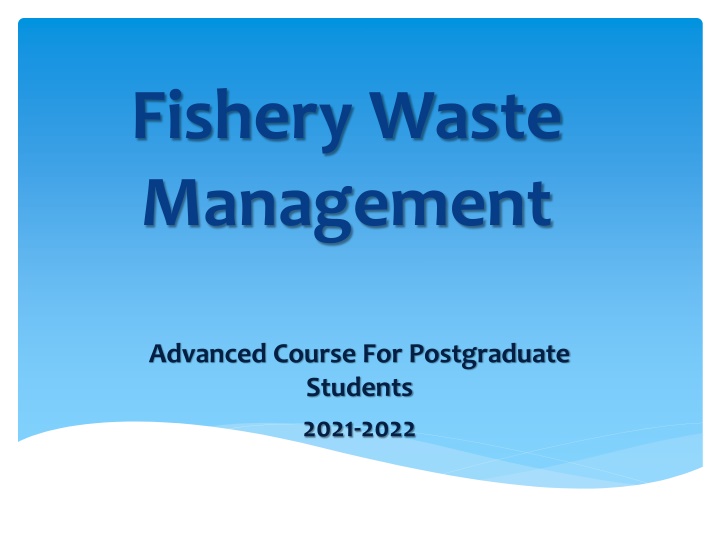
Effective Management of Fishery Waste for Sustainable Practices
Explore the comprehensive course on Fishery Waste Management tailored for postgraduate students, focusing on the differences between Fisheries and Fish, the challenges presented by fish wastes, and the environmental risks associated with improper disposal. Learn about waste management actions, including recycling fish wastes into fertilizers to mitigate environmental concerns and promote sustainable practices.
Download Presentation

Please find below an Image/Link to download the presentation.
The content on the website is provided AS IS for your information and personal use only. It may not be sold, licensed, or shared on other websites without obtaining consent from the author. If you encounter any issues during the download, it is possible that the publisher has removed the file from their server.
You are allowed to download the files provided on this website for personal or commercial use, subject to the condition that they are used lawfully. All files are the property of their respective owners.
The content on the website is provided AS IS for your information and personal use only. It may not be sold, licensed, or shared on other websites without obtaining consent from the author.
E N D
Presentation Transcript
Fishery Waste Management Advanced Course For Postgraduate Students 2021-2022
- Important Definitions: Introduction - Fishery VS Fish o Fishery (PL. Fisheries): A place or geographical location where fish and other aquatic organisms are caught, cultured or handled. o Fish: The known aquatic animals.
Fisheries VS Fish Wastes Fisheries wastes include many fish species or by- catch products having no or low commercial value, undersized or damaged commercial species as well as species of commercial value sufficient amounts to warrant sale. but not caught in Fish wastes may include, but is not limited to, particles of flesh, skin, bones, entrails, shells or liquid stick water.
Waste Management Waste management is defined as the actions or methods of monitoring, transport, processing and recycling or disposal of waste materials. Waste recycling (or disposal) substance through a system that enables that substance to be reused. It involves the collection of waste materials and the separation and clean-up of those materials. Recycling waste means products and consumables produced, saving raw materials and reducing energy consumption. allocation, collection, is to pass a that fewer need new be to
Problem of Fish Wastes Fish temperatures. If not appropriately stored or managed, fish wastes problems and strong odors as a result of bacterial decomposition. components of the waste have a high biological oxygen demand and, if not managed properly, high oxygen demand poses environmental and health problems. wastes degrade rapidly in warm create aesthetic The organic
Environmental Risks of Fish Wastes Some fish wastes are transported for disposal at natural water bodies. Environmental concerns associated with disposal of fish wastes into water bodies include: 1- reduced oxygen levels in the water especially at the bottom; 2- burial or smothering of living organisms; and 3- introduction of disease or non-native and invasive species to the aquatic ecosystem.
Economic Importance of Fish Wastes Fish wastes may contain a variety of important nutrients such as proteins, components which could be used in expanded aquaculture as feedstuffs. Many other components of fish wastes like omega 3 PUFA could be used in human nutrition as well as many pharmaceutical and cosmetic industries. Recycling of fish wastes could be economically profitabl as well as eco- friendly activity. lipids and other
